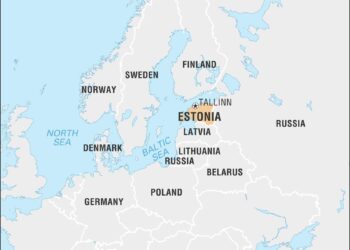In a striking demonstration of military assertiveness, Russian fighter jets have increased their patrols over Estonian airspace, signaling a calculated challenge to U.S. and NATO commitment in the Baltic region. This latest series of maneuvers underscores Moscow’s strategy to test the alliance’s readiness and resolve amid ongoing geopolitical tensions. As Estonia, a frontline NATO member, finds itself at the center of these aerial probes, the international community watches closely to gauge the alliance’s response to Russia’s expanding posture in Eastern Europe.
Jets Over Estonia Signal Putin’s Strategic Testing of Western Defense Commitments
Recent incursions by Russian fighter jets near Estonian airspace have raised alarms among NATO officials, underscoring Moscow’s ongoing strategy to evaluate the alliance’s readiness and willingness to uphold collective defense obligations. These provocative flights are not isolated incidents but rather part of a broader pattern of signaling, where Putin leverages military maneuvers to test the limits of Western resolve. In response, NATO’s rapid reaction forces have been put on heightened alert, emphasizing the alliance’s commitment to deter aggression and reinforce security in the Baltics.
Key elements in this strategic calculus include:
- Frequency and timing: Russian jets often approach during moments of political uncertainty or NATO summits, seeking to exploit potential divisions.
- Rules of engagement: The calculated restraint shown by NATO pilots aims to avoid escalation while signaling robust defense posture.
- Information warfare: These actions serve a dual purpose by feeding Kremlin narratives of Western weakness in Russian media outlets.
| Aspect | NATO Response | Russian Intent |
|---|---|---|
| Airspace Violations | Scrambles and interceptions | Testing reaction times |
| Military Drills | Joint Baltic exercises | Demonstrating regional dominance |
| Diplomatic Messaging | Strong public condemnations | Undermining alliance unity |
Analyzing NATO’s Response Capabilities and Political Cohesion Amid Rising Russian Aggression
In response to increasing Russian military posturing, NATO’s rapid reaction capabilities are under unprecedented scrutiny. The frequent deployment of fighter jets near Estonian airspace signals a deliberate probe of alliance readiness and political unity. NATO’s Integrated Air and Missile Defense systems have been tested continuously, yet experts argue that the real challenge lies in maintaining a coherent and timely decision-making process among member states. Despite substantial investments in defense infrastructure, divergent national priorities complicate swift coordinated responses, highlighting the fragile balance between deterrence and escalation.
Key factors shaping NATO’s current posture include:
- Force Interoperability: Ensuring seamless operation between diverse military technologies remains a hurdle.
- Political Commitment: Varying threat perceptions within member states influence the unity of strategic approaches.
- Resource Allocation: Defense spending disparities impact the alliance’s overall responsiveness.
| Aspect | Status | Implication |
|---|---|---|
| Air Surveillance | Enhanced | Improved early-warning |
| Political Cohesion | Moderate | Potential delays in unified action |
| Rapid Deployment | Developing | Critical for deterrence credibility |
Strengthening Allied Air Defenses and Diplomatic Unity to Deter Future Incursions
In response to increasing aerial provocations near NATO borders, member states have accelerated efforts to bolster their integrated air defense systems. This includes upgrading radar installations, enhancing real-time data sharing across command centers, and deploying advanced interceptor aircraft strategically positioned to cover vulnerable airspace. The implementation of joint training exercises has also been intensified, ensuring that allied pilots and ground crews operate with synchronized precision under high-pressure scenarios.
Key Initiatives Underway:
- Expansion of early-warning radar networks along the Baltic region.
- Deployment of cutting-edge surface-to-air missile batteries.
- Regular cross-border air patrols coordinated among Baltic, Nordic, and Central European allies.
- Enhanced interoperability protocols between U.S. and NATO communication systems.
| Defense Measure | Purpose | Current Status |
|---|---|---|
| Radar Network Expansion | Early detection of incursions | 75% complete |
| Interceptor Aircraft Deployment | Rapid response capability | Operational |
| Cross-NATO Training Exercises | Force integration | Quarterly schedule |
Simultaneously, diplomatic channels remain a crucial front in presenting a united stance against aerial aggression. NATO’s continual emphasis on solidarity among member states has reinforced collective political will, deterring adversaries from exploiting fractures within the alliance. Through regular high-level summits, coordinated statements, and multilateral sanctions discussions, the alliance has signaled that any airspace violation will trigger an immediate and robust response, blending military preparedness with diplomatic resolve.
Concluding Remarks
As tensions persist in Eastern Europe, the recent surge of Russian jets over Estonian airspace underscores Moscow’s ongoing strategy to test the unity and responsiveness of the U.S. and NATO allies. These aerial maneuvers serve as a stark reminder of the fragile security environment and the high stakes involved in maintaining regional stability. Moving forward, the international community will be watching closely to see how Washington and its partners recalibrate their defense posture in response to Russia’s calculated provocations.
















